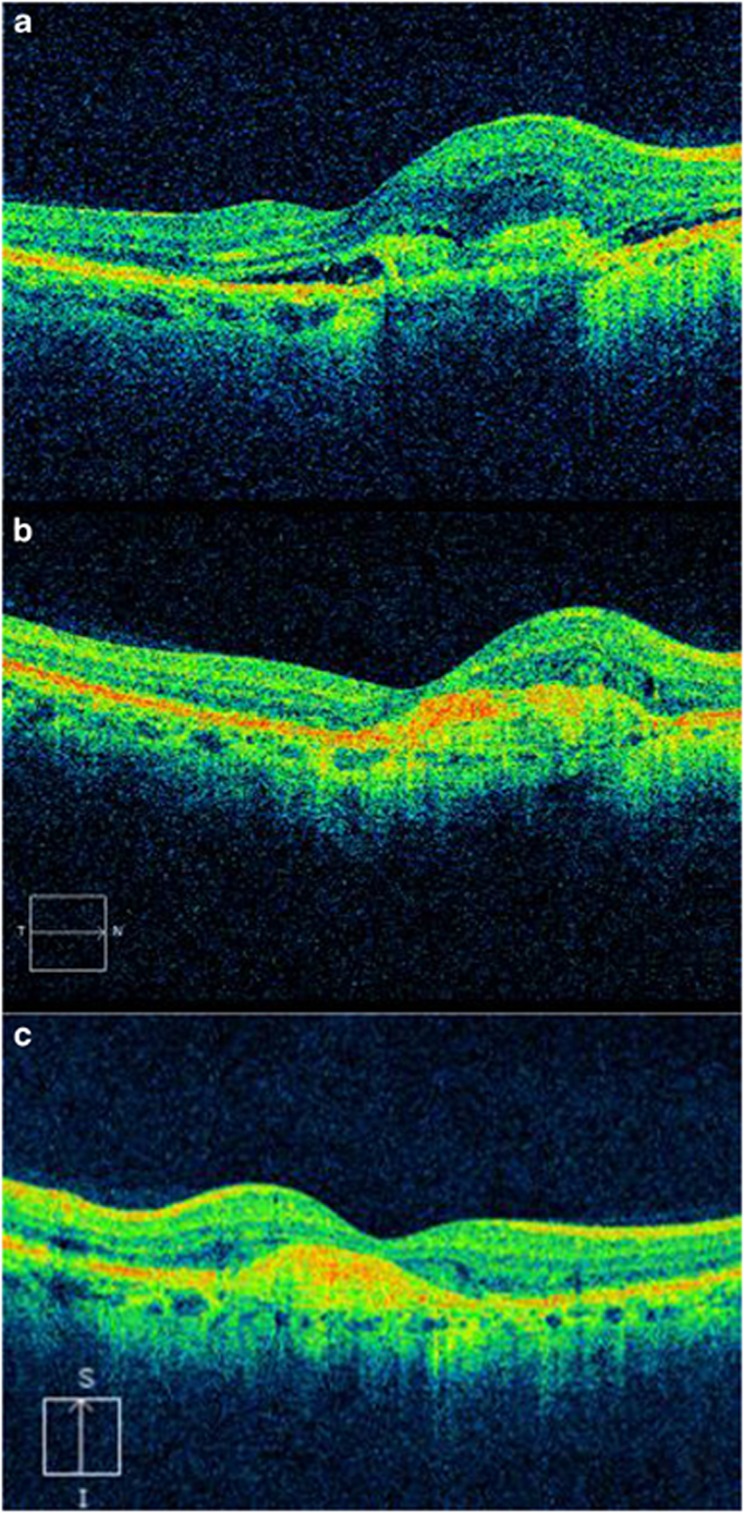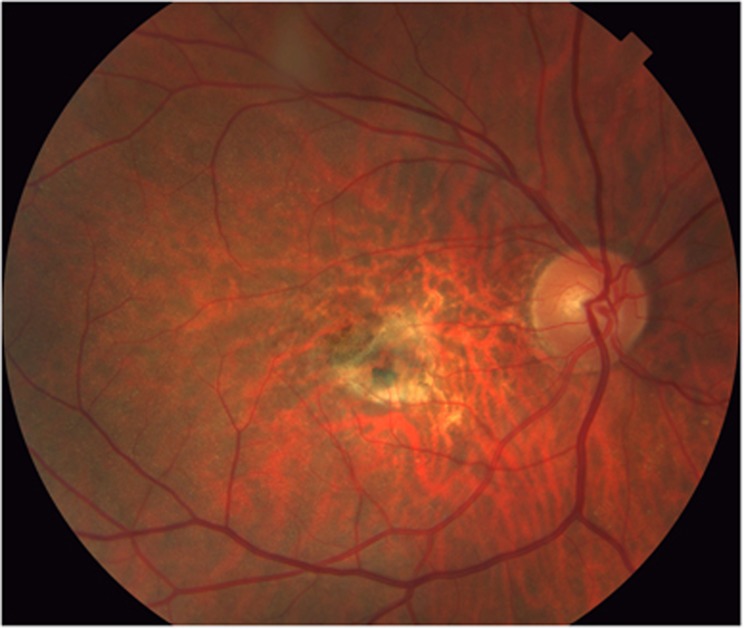Sir,
Sorsby fundus dystrophy is a rare retinal dystrophy of autosomal-dominant inheritance characterized by central vision loss before the fifth decade of life, secondary to choroidal neovascularization (CNV) and/or pigment epithelium atrophy. The natural history of the condition involves early development of lesion fibrosis.1 The genetic background of the disease resides in a mutation in the tissue inhibitor of metalloproteinase 3 (TIMP3) gene.2 We report here a case of Sorsby fundus dystrophy successfully treated with repeated injections of ranibizumab.
Case report
The 41-year-old patient presented in January 2007 with sudden onset distortion of vision in his left eye. Visual acuity was 6/5 OD and 6/18 OS on Snellen chart. Fluorescein angiography revealed OS occult CNV. No treatment was administered, and in October 2007, an extensive macular hemorrhage developed with vision dropping to 6/60. Despite a single session of verteporphin photodynamic treatment in November 2007, the lesion relentlessly progressed to a disciform scar. In April 2009, the patient developed distortion in his right eye with 6/36 vision. A classic subfoveal CNV was identified. DNA analysis revealed the presence of mutation c.610A>T (p.Ser204Cys) in exon 5 of the TIMP3 gene and confirmed the diagnosis of Sorsby fundus dystrophy. After his first intravitreal injection of ranibizumab to the right eye in May 2009 (Figure 1a), vision improved to 6/15. He received 14 injections of ranibizumab for persistent intraretinal fluid identified on optical coherence tomography until February 2011, at which point disease quiescence was established (Figures 1b and 2). Visual acuity stabilized at 6/15 without disease reactivation 6 months thereafter (Figure 1c).
Figure 1.

OCT frames OD, pretreatment, posttreatment, and 6 months after the last injection. (a) OCT frame OD, May 2009 (time of the first injection), showing active CNV with subretinal fluid. (b) OCT frame OD, February 2011 (time of last injection), showing subretinal fibrosis without subretinal fluid. There is a minimal residual intraretinal cyst. (c) OCT frame OD, August 2011 (6 months after last injection), confirming continuous disease quiescence.
Figure 2.

Color Fundus Image OD, February 2011 (time of last injection), revealing fibrosed CNV adjacent to spared functional retina that includes the foveal region justifying preserved visual acuity.
Comment
Therapeutic management of CNV in Sorsby fundus dystrophy remains challenging. Treatment options reported on a limited number of case series include argon laser photocoagulation, PDT alone or in combination with intravitreal triamcinolone and intravitreal bevacizumab.1 Aggressive recurrence has been reported for extrafoveal CNV treated with argon laser,3 while PDT treatment for subfoveal CNV was ineffective.4 Few reports of the use of intravitreal1 or systemic5 bevacizumab have claimed moderate benefit. To our knowledge, this is the first report of the use of ranibizumab in Sorsby fundus dystrophy, with excellent response and long-standing favorable visual outcome. We also would like to draw attention to the extra benefit of effective treatment for CNV in Sorsby fundus dystrophy, in terms of more time spent in active employment, as this condition predominantly affects patients in the productive age range.
Acknowledgments
This work was supported by the NIHR Manchester Biomedical Research Centre.
The authors declare no conflict of interest.
References
- Sivaprasad S, Webster A, Egan C, Bird A, Tufail A. Clinical course and treatment outcomes of Sorsby fundus dystrophy. Am J Ophthalmol. 2008;146:228–234. doi: 10.1016/j.ajo.2008.03.024. [DOI] [PubMed] [Google Scholar]
- Weber BH, Vogt G, Pruett RC, Stohr H, Felbor U. Mutations in the tissue inhibitor of metalloproteinases-3 (TIMP3) in patients with Sorsby's fundus dystrophy. Nat Genet. 1994;8:352–356. doi: 10.1038/ng1294-352. [DOI] [PubMed] [Google Scholar]
- Holz FG, Haimovici R, Wagner DG, Bird AC. Recurrent choroidal neovascularization after laser photocoagulation in Sorsby's fundus dystrophy. Retina. 1994;14:329–334. doi: 10.1097/00006982-199414040-00006. [DOI] [PubMed] [Google Scholar]
- Peiretti E, Klancnik JM, Spaide RF, Yannuzzi L. Choroidal neovascularization in Sorsby fundus dystrophy treated with photodynamic therapy and intravitreal triamcinolone acetonide. Retina. 2005;25:377–379. doi: 10.1097/00006982-200504000-00024. [DOI] [PubMed] [Google Scholar]
- Prager F, Michels S, Geitzenauer W, Schmidt-Erfurth U. Choroidal neovascularization secondary to Sorsby fundus dystrophy treated with systemic bevacizumab (Avastin) Acta Ophthalmol Scand. 2007;85 (8:904–906. doi: 10.1111/j.1600-0420.2007.00927.x. [DOI] [PubMed] [Google Scholar]


